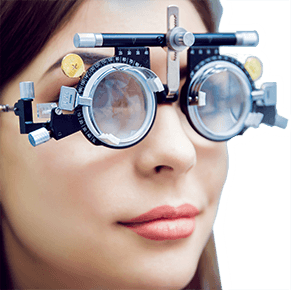Computer glasses: Relieving computer eye strain

When you work at a computer for any length of time, it's common to experience eye strain, blurred vision, red eyes and other symptoms of computer vision syndrome (also called digital eye strain). This is because the visual demands of computer work are unlike those associated with most other activities.
If you're under age 40, eye strain or blurred vision during computer work may be due to an inability of your eyes to remain accurately focused on your screen or because your eyes have trouble changing focus from your keyboard to your screen and back again for prolonged periods. These focusing (accommodation) problems often are associated with digital eye strain.
If you're over age 40, the problem may be due to the onset of presbyopia — the normal age-related loss of near focusing ability. This, too, can cause CVS symptoms.
What can you do? For starters, have a comprehensive eye exam to rule out vision problems and update your eyeglasses prescription. Studies show that even small inaccuracies in your prescription lenses can contribute to computer vision problems.*
If your glasses are up-to-date (or you don't need prescription eyewear for most tasks) and you continue to experience eye discomfort during computer work, consider purchasing customized computer glasses. These special-purpose glasses are prescribed specifically to reduce eye strain and give you the most comfortable vision possible at your computer.
Why computer glasses?
Computer glasses differ from regular eyeglasses or reading glasses in a number of ways to optimize your eyesight when viewing your computer screen.

Eyezen+ is one of the newest lenses designed to optimise vision and comfort during digital device use. According to manufacturer Essilor, the lens filters at least 20% of blue light, but unlike other blue light filters, looks clear instead of tinted.
Computer screens usually are positioned 20 to 26 inches from the user's eyes. This is considered the intermediate zone of vision — closer than driving ("distance") vision, but farther away than reading ("near") vision.
Children and young adults who need prescription eyeglasses usually are prescribed single vision lenses. These lenses correct the wearer's shortsightedness, long sightedness and/or astigmatism, and the shape of the lens inside the eye automatically adjusts to provide the extra magnifying power required for computer vision and near vision.
When a person's close-up vision becomes less clear due to presbyopia after age 40, this age-related loss of natural focusing power affects reading and seeing a smartphone or computer vision clearly and comfortably. Bifocals can provide clear distance and near vision, but intermediate vision (needed for computer use and seeing your smartphone) often remains a problem. Progressive lenses or trifocals, though they offer some help for intermediate vision, often don't have a large enough intermediate zone for comfortable computer work.
Without computer eyeglasses, many computer users often end up with blurred vision, eye strain, and headaches — the hallmark symptoms of computer vision syndrome. Worse still, many people try to compensate for their blurred vision by leaning forward, or by tipping their head to look through the bottom portion of their glasses. Both of these actions can result in a sore neck, sore shoulders and a sore back.
Though they sometimes are called "computer reading glasses," it's best to call eyewear designed specifically for computer use "computer glasses" or "computer eyeglasses" to distinguish them from conventional reading glasses.
Generally, computer glasses have about 60% the magnifying power of reading glasses. But the optimal magnification depends on how far you prefer to sit from your computer screen and how close you like to hold your digital devices.
Computer glasses also should accurately correct any astigmatism you might have, and precise measurements should be taken to insure the optical center of each lens is directly in front of your pupils when you are using your preferred working distance.
For these reasons, computer glasses should be customized to your individual needs. Using weaker, non-prescription reading glasses for computer work and seeing your digital devices typically won't provide the accurate vision correction you need for sustained clarity and comfort.
Computer glasses put the optimum lens power for viewing your computer screen right where you need it for a clear, wide field of view without the need for excessive focusing effort or unhealthful postures. University research also shows custom computer eyewear can significantly increase worker productivity.
SEE RELATED: Computer eye strain: 10 tips to get relief
Lens designs for computer eyewear
Many special purpose lens designs work well for computer glasses. Because these lenses are prescribed specifically for computer use, they are not suitable for driving or general purpose wear.

Computer vision syndrome causes eye fatigue, which can make you feel tired in general.
The simplest computer glasses have single vision lenses with a modified lens power prescribed to give the most comfortable vision at the user's computer screen. This lens power relaxes the amount of accommodation required to keep objects in focus at the distance of the computer screen and provides the largest field of view.
Single vision computer glasses reduce the risk of eye strain, blurred vision and unnatural posture that can cause neck and back pain, and can be used comfortably by young and old computer users alike.
Another popular lens design for computer glasses is the occupational progressive lens — a no-line multifocal that corrects near, intermediate, and, up to a point, distance vision.
Occupational progressive lenses have a larger intermediate zone than regular progressive lenses for more comfortable vision at the computer. But this leaves less lens area for distance vision, so these lenses are not recommended for driving or other significant distance vision tasks.
Other lenses used for computer glasses include occupational bifocal and trifocal lenses. These lined multifocal lenses have larger zones for intermediate and near vision than regular bifocals and trifocals, and the position of the intermediate and near zones can be customized for your particular computer vision needs.
Your optician can help you decide which lens design will best suit your needs for computer glasses.
Lens coatings and tints
For maximum viewing comfort, the lenses of your computer glasses should include anti-reflective coating. Sometimes called anti-glare treatment, anti-reflective (AR) coating eliminates reflections of light from the front and back surfaces of your lenses that can cause eye strain.
Also, computer glasses with photochromic lenses can shield your eyes from potentially harmful high-energy visible blue light from your computer screen and digital devices — and automatically darken in sunlight outdoors too.
Your optician may also recommend adding a light tint to computer glasses to reduce glare caused by harsh overhead lighting and to enhance contrast.
For more details about anti-reflective coating and tints for your computer glasses, consult your eye care professional.
SEE RELATED: Do you need blue light glasses?
Where to buy computer glasses
Resist the temptation to buy over-the-counter reading glasses for use as computer glasses.
Because an accurate eyeglasses prescription is essential if you want to get the full benefits from computer glasses, it's best to purchase this eyewear from a knowledgeable eye care professional.
Prior to scheduling your eye exam, measure how far you like to sit from your computer. Measure from the bridge of your nose to the surface of your computer screen.
Bring this measurement with you to your exam so your optician can use it to help determine the optimum lens power for your computer glasses.
Also, read these computer ergonomics tips to help you arrange your computer workstation for optimum comfort.
READY TO SHOP FOR COMPUTER GLASSES? Find an optical store near you or shop online.
*Productivity associated with visual status of computer users. Optometry. January 2004.
Gina White and James E. Sheedy, OD, also contributed to this article.
Page published on Monday, 6 July 2020






